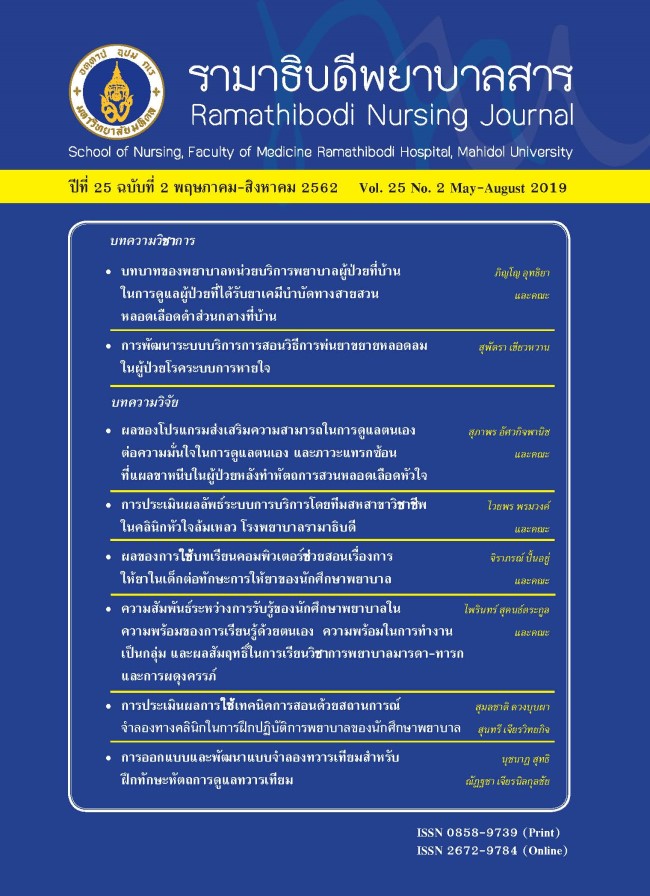Design and Development of a Colostomy Model for Practicing Colostomy Care Skills
Main Article Content
Abstract
Abstract The aim of this design and development research study was 1) to create and develop colostomy model based on anatomy of patients with colostomy for nursing students used to practice procedures of cleaning colostomy, changing and washing colostomy bag in a nursing skill training room and 2) to evaluate the effectiveness of the developed colostomy model. The selection of the sample used the purposive sampling. 110 third-year nursing students of Ramathibodi School of Nursing who enrolled in the Adult and Aging Nursing Practicum 1&2 participated in this study. The instrument used to collect the data was the questionnaire asking for the sample to rate a scale following their opinions on the effectiveness of the developed colostomy model in four aspects including 1) virtual reality, 2) realistic feeling, 3) value, and 4) self-confidence in performing nursing procedures with the patients. The content validity and reliability of the questionnaire were evaluated, resulting in a value of 0.85 and 0.87 respectively. Data were analyzed using descriptive statistics. The results showed that nursing students who used the developed colostomy model in practicing colostomy care procedures expressed their opinions on the effectiveness of the colostomy model at the level of strongly agree in all aspects. The finding indicated that the developed colostomy model was value, realistic feeling, and virtual reality in a level to be used for training nursing students’ procedural skills in colostomy care. However, improving the students’ self-confidence in performing nursing procedures with the patients should not only have a sufficient number of virtual training models, and medical supplies and equipment, but also students should have the opportunity for repeated practice to achieve mastery of the nursing procedural skills and to enhance individual confidence in clinical practice.
Keywords: part-task trainers, colostomy model, colostomy care procedures, psychomotor skill
Article Details
บทความ ข้อมูล เนื้อหา รูปภาพ ฯลฯ ที่ได้รับการตีพิมพ์ในรามาธิบดีพยาบาลสาร ถือเป็นลิขสิทธิ์ของวารสาร หากบุคคลหรือหน่วยงานใดต้องการนำทั้งหมดหรือส่วนหนึ่งส่วนใดไปเผยแพร่หรือเพื่อกระทำการใด ใด จะต้องได้รับอนุญาตเป็นลายลักษณ์อักษรจากรามาธิบดีพยาบาลสารก่อนเท่านั้น
References
Educ in Nurs. 1990;21(5):202-4. doi: https://doi.
org/10.3928/0022-0124-19900901-05
2. Nicholls D, Sweet L, Muller A, Hyett J. Teaching
psychomotor skills in the twenty-first century: revisiting
and reviewing instructional approaches through the lens
of contemporary literature. Medical Teacher.
2016;38(10):1056-63. doi: https://dx.doi.org/10.3 109/0142159X.2016.1150984
3. Chotiban P, Nawsuwan K, Nontaput T, Rodniam J.
Innovation of assisted models for practicing basic nursing
skill. Princess of Naradhiwas University Journal.
2013;5(3):1-12. (in Thai)
4. Daungrat B, Yantarapakon A, Jirasinthipok T, Sayorwan
W, Ratanawiboolsook N, Saleepang N. Development of
latex arm model for suturing practice. Journal of Public
Health and Development. 2009;7(1):48-60. (in Thai)
5. Kasatpibal N, Sawasdisingha P, Whitney JD. Innovation
of educational wound models for nursing students. J Nurs
Educ Pract. 2016;6(9): 101-9.
6. Carmel J, Colwell J, Goldberg MT. Wound, ostomy, and
continence nurses society core curriculum. Ostomy
management. Philadelphia: Wolters Kluwer; 2016.
7. Hendren S, Hammond K, Glasgow SC, Perry WB, Buie
WD, Steele SR, et al. Clinical practice guidelines for
ostomy surgery. Dis Colon Rectum. 2015;58(4):375-
87. doi: 10.1097/DCR.0000000000000347
8. Gutman N. Colostomy guide. United Ostomy Associations
of America; 2011.
9. Prasangsit C. Nursing care of patient with colorectal cancer.
In: Chulaporn P, Kanchana R, Editors. Enterostomal
nursing care: experience from experts. Bangkok: Quality
Development Nursing Division, Department of Nursing,
Faculty of Medicine Siriraj Hospital, Mahidol University;
2015. p. 1-12. (in Thai)
10. Prechaterasat A. Enterostomal therapy nurse’s role: case study in nursing care for rectal cancer patients. Thai Red
Cross Nursing Journal. 2017;10(1):22-34. (in Thai)
11. Rolstad BS, Erwin-Toth PL. Peristomal skin complications:
prevention and management. Ostomy Wound Manage.
2004;50(9):68-77.
12. Herlufsen P, Olsen AG, Carlsen B, Nybaek H, Karlsmark
T, Laursen TN, et al. Study of peristomal skin disorders
in patients with permanent stomas. Br J Nurs.
2006;15(16):854-62. doi: https://doi.org/10.
12968/bjon.2006.15.16.21848
13. Ratliff CR, Scarano KA, Donovan AM, Colwell JC.
Descriptive study of peristomal complications. J Wound
Ostomy Continence Nurs. 2005;32(1):33-7.
14. Hwang YF, Chen SS, Liou TY, Wang HM, Hsu H.
Complications of colostomies and colostomy closure.
Gaoxiong Yi Xue Ke Xue Za Zhi. 1990;6(6):276-82.
15. Yimyam S. Developing stimulation model for training
clinical skill of health science students. Nursing Journal.
2016;43(2):142-51. (in Thai)
16. Bannaasan B. Portable adult arm model for nursing
students’ venipuncture and peripheral intravenous
cannulation practice. Thai Journal of Nursing Council.
2017;32(3):38-49. (in Thai)
17. Chiannilkulchai N, Nunthawong J. Development of the
intramuscular injection model for nursing students and
evaluation of the effectiveness of the model.
Songklanagarind Journal of Nursing. 2016;36(2):65-
77. (in Thai)
18. Chiannilkulchai N, Nunthawong J. The development of
artificial pus wound model for the second year nursing
students training in collecting wound swab culture. Thai
Journal of Nursing Council 2016;31(1):32-43. (in
Thai)
19. Choeychom S, Rujiwatthanakorn D. The use of an
innovative arm model in practicing an intravenous infusion
procedure of nursing students. Rama Nurs J.
2015;21(3):395-407. (in Thai)
20. Chirapaisanphong P. Editor. Ostomy. Bangkok: Bangkok
Medical News; 2012. (in Thai)
21. Chaithat B. Caring for colorectal cancer patients
undergoing ostomies: roles of enterostomal therapy nurses.
Thai Red Cross Nursing Journal. 2016;9(1):19-33. (in Thai)
22. Barr JE. Assessment and management of stomal
complications: a framework for clinical decision making.
Ostomy Wound Manage. 2004;50(9):50-67.
23. Crooks S. Foresight that leads to improved outcome: stoma
care nurses’ role in siting stomas. Prof Nurse.
1994;10(2):89-92.
24. Taiwong A, Saraphok W, Boonmas N, Bunsuk P.
Developing evidence-based nursing innovations for
supporting and promoting necessary self-care for
colostomy patients. Journal of The Royal Thai Army
Nurses. 2018;19(Supplement):41-9. (in Thai)
25. Chianchana C. Creating and developing model. Silpakorn
Educational Research Journal. 2017;9(1):1-11. (in
Thai)
26. Fairbanks RJ, Wears RL. Hazards with medical devices:
the role of design. Ann Emerg Med. 2008; 52(5):519-
21. doi: https://dx.doi.org/10.1016/j.annemergmed.
2008.07.008
27. Chiannilkulchai N, Sutti N. Design and development of
the colostomy bag model for person who has colostomy.
Songklanagarind Journal of Nursing. 2017;37(3):61-
73. (in Thai)
28. Newell KM. Motor skill acquisition. Annu Rev Psychol.1991;42:213-37.

